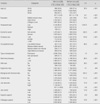Abstract
Methods
Data were obtained from employees aged 20 to 64 using the Korean Working Conditions Survey 2006 (KWCS). Multiple logistic regression analysis using SAS version 9.1 was performed to examine risk factors of work-related stress by gender.
Results
The age-adjusted prevalence of work-related stress among male and female employees was 18.4% and 15.1% respectively. After adjustments for multiple variables among both male and female employees, there was a significant relationship between work-related stress and risk factors including education, company size, work time, ergonomic risks, biological·chemical risks, and job demands. The significant variables for male employees were housework load, occupational class, and shift work, and for female employees, type of employment.
Conclusion
There is a need to develop and support intensive stress management programs nationally giving consideration to work-related stress associated with working time, physical working environment, and job demands. Based on gender specific approaches, for male employes, stress management programs should be developed with consideration being given to occupational class and shift work. For stress management programs for female employees, consideration needs to be given to permanent employment status, specifically those in small companies.
Figures and Tables
References
1. Ahn J, Kim D, Lee S. Nonstandard workers and policy implication (III). 2003. Seoul: Korea Labor Institute.
2. Beehr TA, Farmer SJ, Glazer S, Gudanowski DM, Nair VN. The enigma of social support and occupational stress: Source congruence and gender role effects. Journal of Occupational Health Psychology. 2003. 8:220–231.
3. Burchell B, Fagan C, O'Brien C, Smith M. Working conditions in the European Union: The gender perspective. 2007. Retrieved February 10, 2009. Available from: URL:http://www.eurofound.europa.eu/pubdocs/2007/108/en/1/ef07108en.pdf.
4. Chang SJ, Kang DM, Kang MG, Koh SB, Kim SA, Kim SY, et al. Standardization of job stress measurement scale for Korean employees (The 2nd year project). 2004. Incheon: Occupational Safety and Health Research Institute, Korea Occupational Safety and Health Agency.
5. Chang SJ, Koh SB, Kang MK, Cha BS, Park JK, Hyun SJ, et al. Epidemiology of psychosocial distress in Korean employees. Korean Journal of Preventive Medicine. 2005. 38:25–37.
6. Cho TR. Workers' job stress status and related factors-Using Korean occupational stress questionnaire short form-. Korean Journal of Occupational Health Nursing. 2006. 15:58–71.
7. Costa G. The problem: Shiftwork. Chronobiology International. 1997. 14(2):89–98.
8. Daniels K. Perceived risk from occupational stress: A survey of 15 European countries. Occupational and Environmental Medicine. 2004. 61:467–470.
9. European Foundation for the Improvement of Living and Working Conditions. Quality report of the European working conditions survey. 2007. Retrieved February 10, 2009. Available from: URL:http://www.dataarchive.ac.uk/doc/5639%5Cmrdoc%5Cpdf%5C5639userguide.pdf.
10. Fagan C, Burchell B. Gender, jobs and working conditions in the European Union. 2002. Retrieved February 10, 2009. Available from: URL:http://www.eurofound.europa.eu/pubdocs/2002/49/en/1/ef0249en.pdf.
11. Hawksley B. Work-related stress, work/life balance and personal life coaching. British Journal of Community Nursing. 2007. 12:34–36.
12. Health and Safety Executive. Stress at work-A guide for employers. 1995. Sudbury: Health and Safety Executive.
13. Hong KJ, Tak YR, Kang HS, Kim KS, Park HR, Kwag WH, et al. Job stress, job satisfaction, and health of women who work in the professional jobs: Nurse and teachers. Journal of Korean Academy Nursing. 2002. 32:570–579.
14. Hur SO, Chang SS, Koo JW, Park CY. The assessment of stress between white and blue collar workers by using psychosocial well-being index. Korean Journal of Preventive Medicine. 1996. 29:609–616.
15. Jung HS, Kim HY, Lee HK, Yi YJ, Kwon YS. A structural equation modeling on the factors of stress and coping strategies of married working women. Korean Journal of Occupational Health Nursing. 2001. 10:93–109.
16. Kim YG, Yoon DY, Kim JI, Chae CH, Hong YS, Yang CG, et al. Effects of health on shift-work-general and psychological health, sleep, stress, quality of life. Korean Journal of Occupational Environmental Medicine. 2002. 14:247–256.
17. Koh SB, Son M, Kong JO, Lee CG, Chang SJ, Cha BS. Job characteristics and psychosocial distress of atypical workers. Korean Journal of Occupational Environmental Medicine. 2003. 16:103–113.
18. Korea National Statistical Office. Korean Statistical Information Service: Economically active population survey by age, gender group. 2006. Retrieved January 15, 2009. Available from: URL:from http://www.kosis.kr.
19. Korean standard industrial classification. Korea National Statistical Office. 2007a. Retrieved January, 15, 2009. Available from: URL:http://www.nso.go.kr/std2006/k07a_0000/k07ab_0000/k07ab_0000.html.
20. Korean standard classification of occupations. Korea National Statistical Office. 2007b. Retrieved January 15, 2009. Available from: URL:http://www.nso.go.kr/std2006/data/KSCO_6_1.hwp.
21. Krantz G, Berntsson L, Lundberg U. Total workload, work stress and perceived symptoms in Swedish male and female white-collar employees. European Journal of Public Health. 2005. 15:209–214.
22. Kwon S. The study on gender equality in the family by type of employment of married women. Korean Journal of Social Welfare. 2003. 52:201–221.
23. Lee MS. Working environments and working conditions affecting workers' stress symptoms. Journal of Korean Society for Health Education and Promotion. 2002. 19:107–120.
24. Oh YA, Lee MS, Rhee KY. Relationship between manufacturing workers' job conditions and stress. Korean Journal Occupational Environmental Medicine. 2002. 14:301–314.
25. Parent-Thirion A, Fernández Macías E, Hurley J, Vermeylen G. Fourth European working conditions survey. 2007. Retrieved January 10, 2009. Available from: URL:http://www.eurofound. europa.eu/publications/htmlfiles/ef0698.htm.
26. Park J, Lee N. First Korean working conditions survey: A composition between South Korea and EU. Industrial Health. 2009. 47:50–54.
27. Park JS, Lee GH, Kim JH. Report on Korean working conditions survey in 2006. 2007. Incheon: Occupational Safety and Health Research Institute, Korea Occupational Safety and Health Agency.
28. Rule of industrial health standard. Ministry of government legislation. 2009. 01. 01. Retrieved May 22, 2009. Available from: URL: http://www.law.go.kr.
29. Virtanen P, Vahtera J, Kivimäki M, Pentti J, Ferrie J. Employment security and health. Journal of Epidemiology and Community Health. 2002. 56:569–574.




 PDF
PDF ePub
ePub Citation
Citation Print
Print





 XML Download
XML Download